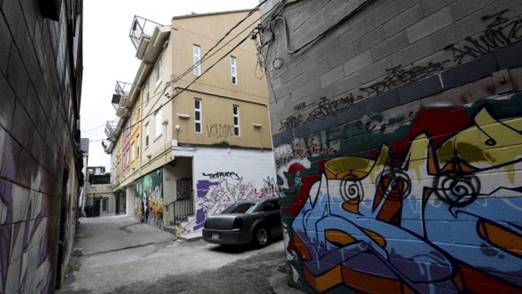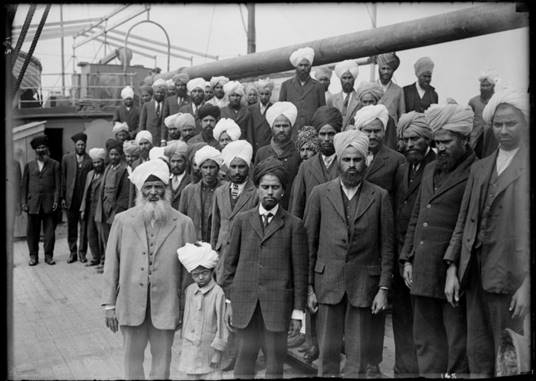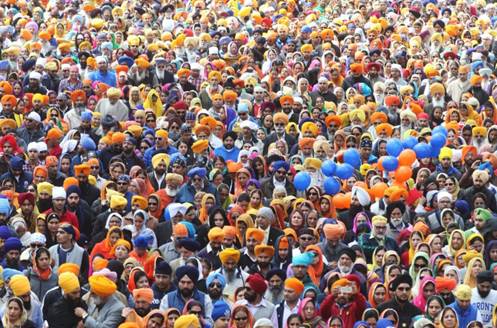Pariahs to power brokers: Sikhs have become a major political force in Canada
By Haroon Siddiqui
The Star : Oct 9, 2017
Sikhs long and arduous journey constitutes a great Canadian story.

NDP Leader Jagmeet Singh revels in the spotlight with his newly announced parliamentary leader, Guy Caron, left, at the House of Commons last week. ( Sean Kilpatrick / THE CANADIAN PRESS)
Of the three historic milestones that Jagmeet Singh represents — the first non-white, first South Asian and first Sikh to become leader of a national party — it is his faith, to which he so visibly and proudly belongs, that is of the utmost symbolic and substantive significance.
A century after facing raw racism on their arrival in British Columbia, Sikhs have emerged a bigger political force than any other visible minority group. Theirs has been a long and arduous journey that, at long last, constitutes a great Canadian story.
In electing Singh as leader, the New Democratic Party atones for the sins of its precursor, the Co-operative Commonwealth Federation, which demonized the Sikhs from India — often mislabeled as Hindus — landing on the west coast in the early 1900s. CCF leader J.S. Woodsworth proclaimed that they were “decidedly grotesque” and “sadly out of place in Canada.”
Echoing him was the labour movement, the other founding pillar of the future NDP. In 1907, the Vancouver Trades and Labour Council passed a motion of “emphatic protest” against the “Hindoo laborers.” The Trades and Labour Council of Canada urged exclusion of “races that cannot be assimilated.”
Reflecting prevailing prejudices, the Vancouver press portrayed the new arrivals as a danger to chaste “white women.”
Article Continued Below
The B.C. legislature in 1907 disenfranchised all “natives of India not of Anglo-Saxon parents,” and barred them from logging on Crown lands as well as entering the legal and medical professions.
Prime Minister Sir Wilfrid Laurier wrote: “The situation with regard to the Hindoos is serious ... and, to speak frankly, I see no solution for it except quietly checking the exodus from India.” His labour minister and future prime minister, Mackenzie King, said, “the Hindu is not suited to the climate of this country.”
In 1908, Ottawa enacted the infamous “continuous journey” law. Those from India would have to travel non-stop to Canada. Except that no shipping line offered direct passage. Which was the point. Other rules disallowed those not speaking a European language, and barred the re-entry of those who had gone home to visit wives and family.
You might be interested in

Suspected ghost hotel ordered closed by city
City inspectors identified health and safety issues after renovations at 38 Kensington Pl. transformed the space into multiple units that were rented out on Airbnb.
Police in Denmark find severed head and legs of Kim Wall, journalist believed killed on submarine
Peter Madsen, a 46-year-old inventor and engineer, is accused of murder in the death of Kim Wall, a 30-year-old reporter who was working on a story about Madsen’s homemade submarine.

Why American gun laws are likely to get looser, not tighter, even after Las Vegas: Analysis
Four dead in another mass killing in the U.S. this week, but only the most sensational of shootings spark a brief national conversation on guns. The rest are routine.
By 1911, the mostly Sikh Indian population in Canada was reduced by half to 2,342.
The first real challenge to these racist policies came from an unexpected quarter. On May 23, 1914, Komagata Maru, a Japanese freighter chartered by Gurdit Singh, an enterprising Sikh from Malaya, anchored in Vancouver’s Burrard Inlet. It carried 376 citizens of the British Raj, 340 of them Sikhs.
“Hindu invaders now in the city harbour on Komagata Maru,” screamed a Vancouver newspaper.
The passengers were not allowed to disembark for two months. Prime Minister Robert Borden had the ship escorted out to the Pacific Ocean.

On May 23, 1914, Komagata Maru, a Japanese freighter chartered by Gurdit Singh, carried 376 citizens of the British Raj, 340 of them Sikhs. ( Leonard Frank / Vancouver Public Library Historical Photographs)
It was not until 72 years later, in May last year, that Ottawa issued a formal apology. Prime Minister Justin Trudeau told the House of Commons: “No words can fully erase the suffering of the Komagata Maru victims. Today, we apologize and commit to doing better.” Canada Post issued a commemorative stamp, featuring the ship and Gurdit Singh. This year, Stratford Festival mounted a new adaptation of the 1976 Sharon Pollock play, The Komagata Maru Incident. Peel Art Gallery and Museum mounted an exhibition in Brampton, where Punjabi is now the second-most spoken language and which Jagmeet Singh has represented in the Ontario Legislature since 2011.
Contemporary influx of Sikhs to Canada began in the 1970s, along with other groups from Asia under liberalized immigration.
That was the time when Sikhs in India were agitating for a separate homeland, Khalistan, the land of the pure. From a relatively peaceful, political protest movement it evolved into a militant campaign, with its leader and armed followers taking refuge in the Golden Temple, the Sikh’s holiest shrine, in Amritsar, in 1982. In 1984, Indian Prime Minister Indira Gandhi ordered the Indian army in.
A reported 1,500 were killed in that military operation. In retaliation, Gandhi was assassinated by her Sikh bodyguards as she came out of her residence in Delhi. That triggered retaliatory attacks on Sikhs in Delhi and elsewhere, killing an estimated 3,000.
In 1985, an Air India flight out of Toronto was blown up by an on-board bomb, off the coast of Ireland, killing 329 people — the worst terrorist incident in Canadian history. Suspicion fell on a group of West Coast Sikhs, but only one, Inderjit Singh Reyat, was convicted (and paroled last year). All the facts were never established due to a prolonged, botched RCMP investigation and despite two federal inquiries.
All this has remained a sore point with India — and also many Canadian Hindus. Both tend to see Sikh critics of India as radical “Khalistanis.”
In 1987, on a foggy July morning, 174 Sikhs were found standing on a highway in Shelburne County, N.S. They had been let off near the shore by a boat. One asked where he could find a taxi to Toronto. Eventually, they were accepted as refugees, as were thousands of other Sikhs.

Around 100,000 people turned out for the Khalsa Day Parade in Toronto on April 26, 2015. ( Colin McConnell / Toronto Star file photo)
In Canada, Sikhs continued battling numerous challenges to their right to wear the turban and kirpan, the ceremonial dagger. In 1989, more than 90,000 Canadians signed a petition opposing turbans in the RCMP. The Reform Party, led by Preston Manning, fully backed that campaign. It was not until 1990 that Baltej Singh Dhillon became the first turbaned Mountie.
Buffeted by overseas and domestic developments, Sikhs started organizing the community. They were soon contesting federal and provincial nominations with vigour. That prompted right-wing media and pundits to repeatedly raise the spectre of “ethnic politics,” with nary a mention of why it has always been laudable for other Canadians to recruit friends, fellow farmers, bankers or any other like-minded group for a political cause but not for the Sikhs.
The 1993 federal election turned out to be a mini-milestone — Sikhs had more seats in the Commons than the Conservatives, three to two.
Gurbax Singh Malhi of Malton became the first turbaned Sikh member of Parliament — in fact, the first in the Western world. During question period in the Commons, he was seated in camera range right behind Jean Chrétien his blazing red turban announcing the emerging new Canada.
Non-turbaned Sikhs also gained national prominence — among them, Herbance Singh (Herb) Dhaliwal, a federal minister, and Ujjal Singh Dosanjh, NDP premier of B.C. who later became a Liberal and was named to the federal cabinet.
Sikh success in Canadian politics and the public sphere since has been remarkable.
Their annual community event, the Khalsa Day is celebrated in every major city. It has become de rigueur for political leaders from the Prime Minister on down to be present. Politicians of all parties routinely visit gurdwaras, Sikh temples, where they take off their shoes, cover their heads as per custom and sit on the floor in separate men’s and women’s sections, and later volunteer at the langar, the dining hall where people take turns serving free food to one and all.
Today, of the 41 elected South Asian members of Parliament and the provincial legislatures, 30 are Sikhs. And last year, Sabi Marwah, the first turbaned Sikh vice-chairman and chief operating officer of the Bank of Nova Scotia, was appointed to the Senate.

Defence Minister Harjit Sajjan displays his service medals as he leaves a Royal Canadian Air Force ceremony on Sept. 1, 2017. ( Chris Young / The Canadian Press)
When Justin Trudeau named four Sikhs to his cabinet — Navdeep Bains, Bardish Chagger, Harjit Sajjan and Amarjeet Sohi — the prime minister boasted that he had more Sikh ministers than the federal cabinet in India.
That ill-advised remark rankled New Delhi, which has also kept a wary eye on several Canadian Sikhs, including Jagmeet Singh. He has been a vocal critic of India’s handling of the 1984 Sikh killings. He has said that the euphemism “riots” is “a misnomer for what happened. These were not riots between the two (communities — Hindus and Sikhs). It was a state-sponsored massacre.”
In 2014, he was denied a visa to India, with Indian spokesmen accusing him of “fomenting contempt” against India. He responded that India “continues to use visa denial as a form of silencing its critics.”
In April this year, he voted for a motion passed at the Ontario Legislature describing the 1984 killings as “genocide.”
Singh’s rise to the leadership of the NDP clearly changes the Canadian political calculus.
Sikhs used to vote overwhelmingly for the Liberals. The Conservatives have made inroads in recent years. The NDP less so, partly because Sikhs tend to be socially conservative, as seen in their objections to the changes in sex education curriculum in Ontario schools, something that Singh initially opposed.
But with his new national status, “there’ll be much interest in the NDP among the Sikhs, in a big way, especially in Brampton and Mississauga, and out west in Surrey and Delta in B.C., and in Edmonton,” says Harinder Takhar, MPP for Mississauga-Erindale.
Takhar ran for the leadership of provincial Liberal party in 2013, losing to Kathleen Wynne. To delegates at that convention, he made a poignant personal observation: one of his greatest regrets was to have cut his hair and beard in the 1970s to get a job — “I ended up losing a part of myself.”
He sees the rise of Jagmeet Singh, the unapologetic observant Sikh, as “a great leap forward in multicultural Canada.”
In an interview, Takhar said that Singh’s ascendance has “serious ramifications for all parties at both the federal and provincial level” — beyond the voting patterns in the Sikh community, now estimated at 750,000 across Canada.
“His greater impact would be on policy,” given his social justice agenda.
Singh, a frequent victim of racial profiling — he says he has been pulled over 11 times by police — has long campaigned against carding.
In the post-9/11 period, he has felt the lash of being mistaken as a Muslim. He has been firm in defending the right of Muslim women to wear the hijab and the niqab, even if the latter stance has rankled some Quebecers. Lately, he has tried to finesse the issue by saying that he respects Quebec’s jurisdiction but that he thinks the courts would overturn a ban on the niqab, anyway.
His bigger hope is to convince Quebecers to consider what’s in his head, not what’s on it.
It remains to be seen whether he’d be allowed to enter the Quebec National Assembly with his turban and dagger. And whether India would deny him entry to the land of his parents’ and his people’s birth.
Jagmeet Singh’s success closes some chapters of Canada’s checkered history in dealing with diversity. And it opens several others, with national and international implications.
Alok Mukherjee, former chair of the Toronto Police Services Board, and Haroon Siddiqui, former columnist and editorial page editor emeritus of the Toronto Star, are distinguished visiting professors at Ryerson University.
